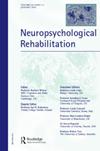踝足矫形器对中风患者双任务行走活动能力的影响?一项横断面双因素因子设计临床试验。
IF 1.7
3区 心理学
Q4 NEUROSCIENCES
引用次数: 0
摘要
摘要目的评估踝足矫形器(AFO)对中风后幸存者在双任务行走过程中的活动能力和步态的影响。在这项采用因子设计的横断面试验中,中风幸存者随机完成了四项任务:(1)使用踝足矫形器的双任务步行;(2)使用踝足矫形器的单任务步行;(3)不使用踝足矫形器的双任务步行;以及(4)不使用踝足矫形器的单任务步行。主要结果是定时起立行走(TUG)测试,次要结果包括步态指标、Tinetti评分和听觉N-back测试。结果显示,48 名受试者(38 名男性和 10 名女性;19-65 岁)完成了试验。在单任务和双任务条件下,与非 AFOs 条件相比,患者使用 AFOs 的 TUG 得分更高(95% CI:7.22-14.41,P <0.001)。次要结果显示,在双任务行走过程中,使用 AFO 后效果明显增强,在步态指标、平衡和认知功能方面具有显著的交互效应(P < 0.05)。虽然没有统计学意义,但在双任务行走期间,TUG和行走速度的双任务效应更为明显。总之,AFO能增强中风后幸存者在单任务和双任务行走时的活动能力和步态。本文章由计算机程序翻译,如有差异,请以英文原文为准。
The impact of ankle-foot orthoses on mobility of dual-task walking in stroke patients? A cross-sectional two-factor factorial design clinical trial.
ABSTRACTTo assess the impact of ankle-foot orthoses (AFOs) on mobility and gait during dual-task walking in post-stroke survivors. In this cross-sectional, factorial design trial, stroke survivors performed four randomized tasks: (1) dual-task walking with AFOs, (2) single-task walking with AFOs, (3) dual-task walking without AFOs, and (4) single-task walking without AFOs. Primary outcome was the Timed Up and Go (TUG) test, with secondary outcomes including gait metrics, Tinetti scores, and auditory N-back tests. In the results, 48 subjects (38 males and 10 females; 19-65 years) completed the trial. Patients had a greater TUG score with AFOs compared with non-AFOs conditions (95% CI: 7.22-14.41, P < 0.001) in single-task and dual-task conditions. Secondary outcomes showed marked enhancement with AFOs during dual-task walking, with significant interaction effects in gait metrics, balance, and cognitive function (P < 0.05). Although not statistically significant, dual-task effects of TUG and walking speed were more pronounced during dual-task walking. In conclusion, AFOs enhance mobility and gait during both single and dual-task walking in post-stroke survivors.
求助全文
通过发布文献求助,成功后即可免费获取论文全文。
去求助
来源期刊
CiteScore
6.30
自引率
7.40%
发文量
78
审稿时长
>12 weeks
期刊介绍:
Neuropsychological Rehabilitation publishes human experimental and clinical research related to rehabilitation, recovery of function, and brain plasticity. The journal is aimed at clinicians who wish to inform their practice in the light of the latest scientific research; at researchers in neurorehabilitation; and finally at researchers in cognitive neuroscience and related fields interested in the mechanisms of recovery and rehabilitation. Papers on neuropsychological assessment will be considered, and special topic reviews (2500-5000 words) addressing specific key questions in rehabilitation, recovery and brain plasticity will also be welcomed. The latter will enter a fast-track refereeing process.

 求助内容:
求助内容: 应助结果提醒方式:
应助结果提醒方式:


